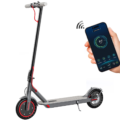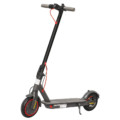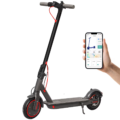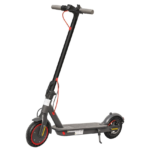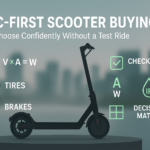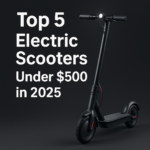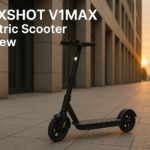- Home
- Scooters
- Electric Scooters
- JUICEASE ESMAX
JUICEASE ESMAX
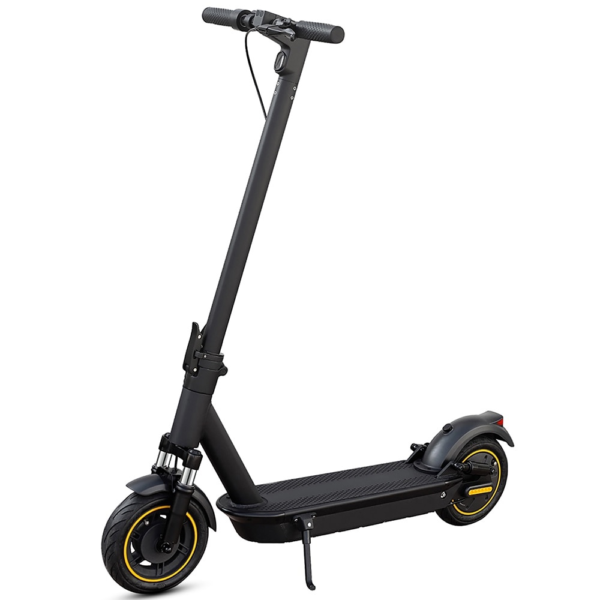


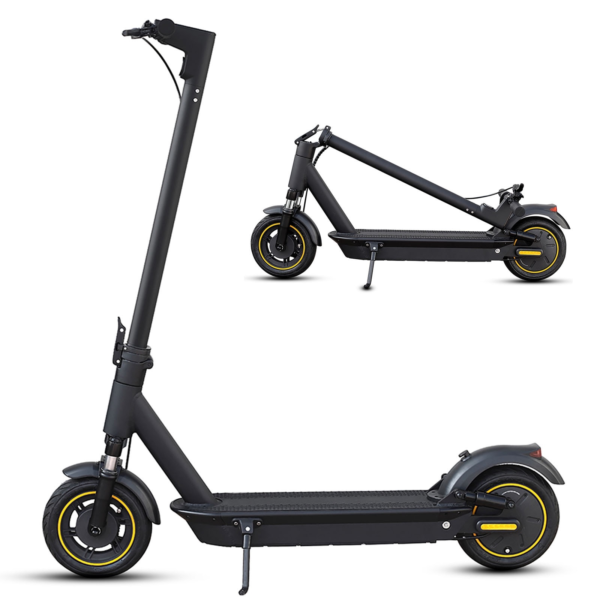
- Battery Range: 22–28 miles (35–45 km)
- Top Speed: 21.7 mph (35 km/h)
- Motor Power: 500 W
- Weight Capacity: 265 lb (120 kg)
- Charging Time: 4–5 hours
- Scooter Weight: 40.8 lb (18.5 kg)
PROS
- Dual suspension (front & rear)
- 10″ pneumatic tires
- Front drum + rear electronic braking
- App lock + speed limit setting
- Max load 265 lb (120 kg)
- Folds in ~3 seconds
CONS
- IP rating not specified
- Heavier at 40.8 lb (18.5 kg)
- Rear brake is electronic (no rear disc)
- Specs may vary by app version/region


Table of contents
- What Is the JUICEASE ESMAX?
- How the JUICEASE ESMAX Works
- Key Specifications (clean table)
- Design & Build Quality
- Performance Fundamentals
- Battery, Range & Efficiency
- Ride Quality & Comfort
- Braking & Safety Features
- Portability & Daily Usability
- Maintenance & Care
- Weather & Seasonal Considerations
- JUICEASE ESMAX vs Alternatives
- Who the JUICEASE ESMAX Is (and Isn’t) For
- FAQs
- Glossary
- Final Thoughts
The JUICEASE ESMAX is a practical, durable, and straightforward commuter scooter for daily city travel. It pairs a 500 W hub motor with a 42 V, 14.5 Ah battery and dual suspension so rides feel predictable and calm. Consequently, new riders can focus on traffic rather than fighting throttle surge; if you’re comparing within the lineup, the JUICEASE E1 Pro is a close sibling geared to similar city duties. This overview explains what it is, how it works, and how to use the official specifications to set realistic expectations.
What Is the JUICEASE ESMAX?
At its core, the JUICEASE ESMAX is an adult electric kick scooter built for reliable commuting. Rather than chase extreme speed, it emphasizes smooth control, sensible range, and easy upkeep. As a result, the scooter fits short cross-town trips, routine campus moves, and last-mile hops from bus or train. Additionally, its 10-inch wheels, dual suspension, and front-drum/rear-electronic braking create a stable platform for mixed pavement.
The deck offers enough room for a relaxed, staggered stance. Meanwhile, the fold couples the stem to the rear fender for quick storage in small spaces. The display is simple, the cockpit is tidy, and the thumb throttle encourages fine control in crowded bike lanes. Overall, the package feels like a dependable daily tool rather than a weekend toy.
How the JUICEASE ESMAX Works
Motor & controller. The rear hub houses a 500 W brushless DC motor, and a sine-wave controller meters power in smooth pulses. Therefore, roll-ons feel progressive instead of jerky. Think of it like a well-tuned automatic transmission: you press gently, and the scooter eases forward without drama. Moreover, the calm mapping helps traction on paint lines, bricks, and older asphalt.
Battery & power delivery. A 42 V, 14.5 Ah pack favors ride time over peak velocity. Consequently, the scooter performs best at city speeds and on rolling terrain. However, energy draw climbs with hills, wind, and cold. Plan your route with this in mind. Typically, the included 42 V/2 A charger brings the pack from low to full in about 4–5 hours, which suits overnight top-ups or midday boosts.
Throttle & ride modes. The thumb throttle is direct yet forgiving. In addition, three speed presets help you match conditions: low for crowded areas, medium for mixed paths, and sport for open streets. Through the companion app, you can set a speed cap, switch between kick-to-start and zero-start, and enable cruise control. Hold a steady pace for several seconds and cruise will take over; tap the brake or throttle to exit. Consequently, long flat stretches feel less tiring.
Brakes. Up front, a drum brake delivers consistent bite with little maintenance. In back, an electronic brake adds gentle motor braking and a touch of regenerative feel. Because the system is tuned for urban speeds, it rewards early planning. Squeeze deliberately, look ahead, and you will scrub speed smoothly.
Key Specifications (clean table)
The table below summarizes the official specifications for the model. Units are shown US-first, with metric in parentheses for clarity.
| Block | Item | Value |
|---|---|---|
| General | Model | ESMAX (adult electric scooter) |
| Color | Black | |
| Max rider load | 265 lb (120 kg) | |
| Performance & Power | Motor | 500 W rear hub |
| Default top speed | 15.5 mph (25 km/h) | |
| App-adjustable cap | Up to ~21.7 mph (35 km/h), where legal | |
| Speed modes | Three presets (low / mid / sport) | |
| Battery, Charging & Electrical | Battery | 42 V, 14.5 Ah |
| Charger | 42 V, 2 A (100–240 V input) | |
| Charge time | ~4–5 hours from low | |
| Claimed range | 22–28 mi (35–45 km), rider/terrain dependent | |
| Build & Dimensions | Tires | 10-inch diameter |
| Suspension | Dual (front and rear) | |
| Weight | 40.8 lb (18.5 kg) | |
| Size (unfolded) | 46.5 × 18.5 × 48.8 in (1180 × 470 × 1240 mm) | |
| Folded size | 46.5 × 18.5 × 22.0 in (1180 × 470 × 560 mm) | |
| Deck (usable) | ~19.3 × 6.7 in (49 × 17 cm) | |
| Safety & Control | Brakes | Front drum + rear electronic |
| Lighting | Stem-mounted LED headlight | |
| Features & Extras | Connectivity | Bluetooth app: speed cap, cruise, light toggle, lock |
| Start mode | Kick-to-start or zero-start | |
| Cruise Control | Yes | |
| Warranty & Compliance | Warranty | Up to 2 years on core components (region dependent) |
| Compliance notes | Follow local rules; avoid heavy rain and standing water |
Design & Build Quality
The frame uses forged aluminum alloy, which keeps mass reasonable while remaining sturdy. As a result, the scooter feels planted over expansion joints and patched concrete. Furthermore, the tall stem locks to the rear fender when folded, and the lever-style hinge is quick once you learn the motion. Keep the hinge hardware snug; in return, it stays silent and free of shake.
The deck is long and fairly narrow. Therefore, most riders will favor a staggered stance with the rear foot angled. The rubberized mat grips well in dusty conditions, and the fenders shield spray from the wheels. Meanwhile, cable routing is tidy, the display is readable in daylight, and the thumb throttle sits where your hand naturally rests. Nothing is extravagant; however, the fit-and-finish feels purposeful and tidy.
Finally, the dual-suspension layout does subtle work. It filters harshness from cracked surfaces without adding much complexity. Consequently, you can ride longer with less hand and forearm fatigue.
Performance Fundamentals
Acceleration feel. Off the line, the scooter moves away smoothly. Because the controller is sine-wave, small inputs translate to small pushes. This, in turn, improves balance at walking pace and while merging. Moreover, sport mode adds enough urgency to clear lights without wheelspin.
Cruising stability. Once at pace, the 10-inch wheels and suspension damp the high-frequency chatter of seams and paint lines. In practice, the chassis feels settled near the default limiter. Nevertheless, tire pressure and headset tension still matter. Check both regularly. Consequently, the scooter tracks straight and resists bar waggle.
Hill behavior. On 7–10% grades, expect speed to dip. That said, smooth power delivery keeps traction predictable. Start hills with a small run-up, choose sport mode, and hold a steady thumb position. Although it is not a hill-climb specialist, it remains steady and cooperative.
Battery, Range & Efficiency
The 42 V, 14.5 Ah pack aims for dependable daily range. Under temperate weather and moderate pacing, the claimed 22–28 miles (35–45 km) is achievable. However, real-world results vary. Speed, rider mass, climb frequency, and wind all influence consumption.
- Rider weight. Heavier riders draw more current during starts and climbs; therefore, range shortens.
- Terrain. Frequent hills increase watt-hours per mile; conversely, flat bike paths reduce draw.
- Pace. Every extra mile per hour costs energy; cruise control helps keep it steady.
- Temperature. Cold suppresses chemical activity; warm the pack indoors when possible.
Additionally, charge routines matter. The included 42 V/2 A charger is gentle on the pack, so partial top-ups are fine. Avoid storing the battery at 0% or 100% for days. Instead, park around 50–60% if you will pause for a week. As a result, long-term health improves. Finally, wipe dust away with a damp cloth and keep the port cap seated; do not hose the scooter.
Importantly, this section references the published specifications for capacity and voltage, which set the baseline for planning.
Ride Quality & Comfort
Tires and suspension. The combination of 10-inch tires and dual suspension takes the sting out of sharp edges. If your unit uses solid tires, the ride will feel firmer yet nearly puncture-proof. If yours ships with pneumatic tires, comfort improves, though pressure checks become essential. Either way, the suspension reduces buzz and helps the bar stay calm over cracks.
Ergonomics. The bar height suits most adults, and the narrow deck encourages a compact stance. Additionally, the thumb throttle reduces wrist strain compared with some trigger designs. Because the acceleration map is gentle, you can creep along in shared spaces without wobble.
Stem flex. At city speeds, flex is modest. Nevertheless, you should bend your elbows and soften your knees at higher pace. This athletic stance lets the scooter float under you. Consequently, straight-line stability improves and small hits feel less abrupt.
Braking & Safety Features
Braking system. The front drum brake is the star here. It’s sealed from grit, delivers predictable bite, and remains quiet when adjusted. Meanwhile, the rear electronic brake slows the motor and adds a small regenerative feel as you roll off. Together, they favor composure over drama. Plan ahead, squeeze smoothly, and the scooter will slow in a controlled arc.
Lights and visibility. The stem-mounted LED headlight helps others notice you at dusk. For better conspicuity, pair it with reflective ankle bands or a light on your helmet. Additionally, position the beam so it lights the path without dazzling oncoming walkers.
Water exposure. The body uses resistant design cues; however, best practice is to avoid heavy rain and standing water. After splash, dry the deck and wipe the brake area. Consequently, parts last longer and braking remains consistent.
Legal notes. Rules vary by region. Therefore, set the app’s speed cap to match local limits, ride predictably, and use a bell for courteous overtakes.
Portability & Daily Usability
Weight & carry. At 40.8 lb (18.5 kg), the scooter is portable enough for one flight of stairs. Two or three flights are doable yet tiring. Therefore, plan your storage spot ahead of time. Elevators and train vestibules are usually simple thanks to the compact fold.
Fold mechanism. Flip the lever, lower the stem, and hook it to the rear fender. With practice, the sequence takes seconds. Because the folded size is 46.5 × 18.5 × 22.0 in (1180 × 470 × 560 mm), it slides under many desks or alongside café seating. Additionally, the hook holds firmly during short carries.
Storage habits. Store indoors when possible. Avoid extreme heat or freezing balconies. If pausing for a month, charge to 50–60% and top up every few weeks. Consequently, the pack ages more gracefully.
Security. Use a quality lock through the stem to a fixed object. Moreover, remove small accessories and avoid leaving the charger in a visible bag. Layering deterrents—location, time, and lock—reduces risk.
Maintenance & Care
A light, regular routine keeps the scooter feeling tight and quiet.
- Before each ride (30–60 seconds). Check latch closure, squeeze the brake, and confirm the headlight works. Spin wheels and listen for scraping. Consequently, small issues surface early.
- Weekly. If you have pneumatic tires, check pressure. If you run solid tires, inspect the beads and tread for cuts. Wipe dust from the deck and charging area. In addition, confirm cable routing is clear of snags.
- Monthly. Check hinge hardware and deck bolts. A quarter-turn on a loosening fastener prevents creaks. Review the app for firmware updates, then test with a short ride.
- Every 3–6 months. Inspect the front drum’s cable for stretch. Replace worn friction parts on time. Also, examine rear fender mounts and the latch catch for play.
Charging care. Place the charger on a hard surface with airflow. Do not charge immediately after a very cold or very hot ride; instead, let the pack normalize first. Unplug once full to reduce idle hours. Therefore, heat and standby stress remain low.
Weather & Seasonal Considerations
Rain. Even with seals, wet weather shortens braking distance and reduces traction. Slow down, avoid painted markings, and lengthen your following gap. Afterward, dry the deck and wheel area. Consequently, you keep bearings and brake parts happier.
Heat. High heat accelerates battery and tire wear. Park in shade when possible, and crack a car window if transporting the scooter. Let the pack cool before charging. As a result, long-term health improves.
Cold. Range dips in cold temperatures. Start with a warm pack, lower your speed, and accept a more relaxed pace. Additionally, expect the front drum to gain bite again after a few stops as the mechanism warms.
Dust and grit. Winter sanding and construction debris can work under seals. Therefore, wipe down the hinge, deck, and brake areas after dusty rides. A five-minute cleanup prevents many squeaks.
JUICEASE ESMAX vs Alternatives
Against commuter-class scooters. The ESMAX stands out for calm throttle mapping, dual suspension, and a front drum paired with rear electronic braking. Many budget commuters use a single rear brake or no suspension at all. Consequently, the ESMAX feels steadier on broken pavement and more composed in stop-and-go traffic.
Against performance-class scooters. High-output models climb harder and stop with hydraulic systems, yet they weigh more and eat range at speed. If your route is mostly flat city riding with occasional hills, the ESMAX’s balance of weight, range, and control often makes more practical sense. Moreover, the simpler hardware usually means less tinkering.
Against off-road scooters. Off-road builds bring knobby tires and long travel. They are heavy indoors and hum on pavement. Unless you truly ride dirt, a city-tuned chassis like this is easier to live with. Therefore, commuters tend to prefer the ESMAX’s portability and manners.
Who the JUICEASE ESMAX Is (and Isn’t) For
Great for:
- Daily commuters who want consistency and low fuss.
- Students and staff shuttling between buildings.
- Multi-modal riders who fold for trains or rideshares.
- New riders who value smooth mapping and predictable braking.
- Anyone who prefers app features like cruise, speed caps, and a simple lock.
Not ideal for:
- Riders chasing high-speed thrills or steep, extended climbs.
- Off-road explorers on loose dirt, gravel, or mud.
- People who must ride in heavy rain; conservative habits are wiser.
In short, choose it for calm control and straightforward upkeep; look elsewhere for aggressive speed or rugged off-road work.
FAQs
1) What’s the real-world top speed?
By default, the limiter holds 15.5 mph (25 km/h). Through the app, you can raise the cap—up to roughly 21.7 mph (35 km/h)—where permitted. However, always match local rules and conditions.
2) How far can I go on one charge?
The claim is 22–28 miles (35–45 km), depending on rider, terrain, pace, and temperature. Consequently, cold or hilly routes will shorten range.
3) Does it have cruise control?
Yes. Enable it in the app, hold a steady speed, and it engages automatically. Tap brake or throttle to exit. Therefore, long bike-path segments feel easier.
4) What brakes does it use?
A front drum brake and a rear electronic brake. The front provides consistent bite; the rear adds smooth motor braking. Together, they encourage early, controlled stops.
5) Is it water-resistant?
It uses resistant design cues; nevertheless, avoid heavy rain and standing water. Dry the scooter after splash. Consequently, parts last longer and performance stays steady.
6) What are the folded size and weight?
Expect about 46.5 × 18.5 × 22.0 in (1180 × 470 × 560 mm) and 40.8 lb (18.5 kg). As a result, desks, trains, and elevators are typically manageable.
7) Where can I find a concise JUICEASE ESMAX overview?
You’re reading it. This JUICEASE ESMAX overview distills practical guidance and the official specifications into one place for quick reference.
Glossary
- Ah (Amp-hour): Battery capacity over time; higher usually means longer range.
- Wh (Watt-hour): Energy content (voltage × amp-hours); more Wh equals more stored energy.
- Controller: Electronic unit that meters battery power to the motor based on throttle input.
- Sine-wave controller: Variant that outputs smooth, quiet power for linear response.
- Regen (regenerative braking): Motor-based slowing that can return a little energy to the pack.
- Drum brake: Enclosed brake with shoes that press inside a drum; low maintenance and weather-friendly.
- Kick-to-start: Requires a small push before the motor engages; prevents sudden launches.
- Zero-start: Allows starts from a standstill with throttle; convenient on open paths.
- Stem flex: Small fore-aft movement at the steering column; modest flex is normal.
- Deck: Standing platform; length and width shape stance comfort.
- IP rating: Code for dust and water protection; not every model publishes one.
- Top-speed limiter: Software cap that sets maximum speed; helpful for matching local rules.
- Range: Distance per charge; affected by speed, weight, terrain, and temperature.
- Throttle mapping: How controller translates thumb input into motor power.
- Suspension travel: How much the fork or rear can compress to absorb bumps.
Final Thoughts
Ultimately, the JUICEASE ESMAX favors calm control, predictable manners, and simple upkeep. The 500 W hub motor and sine-wave controller make starts smooth; the dual suspension keeps chatter in check; and the front drum with rear electronic braking delivers steady stops. Meanwhile, the 42 V, 14.5 Ah pack supports everyday distance without adding excess weight. If your goal is a dependable city scooter that respects your routine, this platform makes everyday sense. Moreover, its published specifications map cleanly to how it rides in the real world—balanced, friendly, and ready for the commute.
Specifications
General
| Model The Model specifies the exact version or name of the scooter. It helps identify its unique design, features, and specifications within the manufacturer’s product line. Knowing the model makes it easier to compare options, find compatible accessories, or look up support information. | ESMAX |
| Brand The Brand identifies the manufacturer or company that designs and produces the scooter. A trusted brand is a sign of quality, reliability, and good customer support. Well-known brands often have higher standards for safety, performance, and after-sales service, giving you more confidence in your purchase. | JUICEASE |
| Release Date The Release Date indicates when the scooter model was officially launched on the market. This helps you know how current the design, technology, and features are. A newer release date often means updated components, improved performance, and the latest safety or smart features. | 17 November 2025 |
| Recommended Age Recommended Age indicates the minimum age range that the scooter is designed for, based on safety, size, and ease of use. Following the recommended age helps ensure that riders can handle the scooter’s speed, weight, and controls comfortably and safely. Always check local laws and use protective gear, especially for younger riders. | 14+ |
Performance & Power
| Motor Power (Wattage) What it means: The motor power, measured in watts (W), shows how strong the scooter’s electric motor is. Why it matters: Higher wattage usually means better acceleration, more torque, and improved performance on hills or rough terrain. For example, a 250W motor is good for flat city roads and light riders, while a 500W or 1000W motor provides more power for faster speeds or climbing steep inclines. | 500 W brushless hub motor |
| Top Speed The Top Speed indicates the maximum speed that the scooter can reach under optimal conditions. It’s usually measured on level ground with a fully charged battery and an average rider weight. A higher top speed allows you to travel longer distances faster, but always ensure you ride within legal speed limits and your personal comfort zone for safety. | 21.7 mph (35 km/h); region default 15.5 mph (25 km/h) |
| Battery Capacity Battery Capacity refers to the total amount of energy the scooter’s battery can store, usually measured in ampere-hours (Ah) or watt-hours (Wh). A higher battery capacity means you can ride longer distances on a single charge, reducing the need for frequent recharging. Keep in mind that actual range can vary depending on rider weight, terrain, speed, and weather conditions. | 42 V 14.5 Ah |
| Estimated Range per Charge The Estimated Range per Charge indicates the average distance the scooter can travel on a single full battery charge. This range is calculated under optimal conditions, such as flat terrain, moderate speed, and average rider weight. Real-world range may vary depending on riding style, terrain, weather, and load. A longer range means fewer recharges and greater freedom for longer trips. | 22–28 miles (35–45 km) |
| Hill Climb Ability Hill Climb Ability describes the maximum incline or slope that the scooter can handle while maintaining stable performance. It’s typically expressed as a percentage or in degrees. A higher hill climb rating means the scooter can tackle steeper hills without losing too much speed or power. Actual climbing performance may vary based on rider weight, battery charge, and terrain conditions. | Up to 30° |
| Drive System The Drive System refers to how power from the motor is delivered to the wheels. Electric scooters typically use either a hub motor (directly integrated into the wheel) or a chain/belt drive system. A high-quality drive system ensures smooth acceleration, efficient power transfer, and low maintenance. The choice of drive system affects performance, noise level, and overall ride experience. | Not specified |
Charging & Electrical
| Charging Time Charging Time indicates how long it takes to fully recharge the scooter’s battery from empty to 100% using the standard charger provided. Faster charging means less downtime and more time on the road. Actual charging time may vary slightly depending on battery capacity, charger output, and environmental conditions. | Approx. 4–5 hours |
| Battery Type Battery Type refers to the specific technology used in the scooter’s battery, which affects performance, lifespan, weight, and charging time. Most modern electric scooters use high-quality lithium-ion (Li-ion) batteries because they offer a good balance of energy density, durability, and low maintenance. A reliable battery type ensures consistent power delivery and longer riding ranges. | Lithium-ion battery pack |
| Removable Battery A Removable Battery means the battery pack can be easily detached from the scooter for convenient charging and replacement. This feature allows you to charge the battery separately, swap it with a spare for extended range, or securely store it indoors in extreme weather. Removable batteries add flexibility and make it easier to keep your scooter powered up wherever you are. | Non-removable internal battery (fixed pack) |
| Regenerative Braking Regenerative Braking is an energy-saving feature that converts some of the energy normally lost during braking back into battery power. When you slow down or brake, the motor works in reverse to generate electricity, which helps extend the scooter’s range and improves overall efficiency. This system also reduces wear on traditional brake components, leading to lower maintenance over time. | Not specified |
| Lighting Lighting refers to the built-in front and rear lights that enhance visibility and safety when riding in low-light conditions or at night. Good lighting helps you see the road ahead and ensures that other road users can see you. Many scooters include LED headlights, taillights, and sometimes brake lights or side reflectors for added safety and compliance with local traffic regulations. | LED headlight & tail light; left/right turn indicators |
Build & Dimensions
| Scooter Weight Scooter Weight refers to the total weight of the scooter when fully assembled, including the battery. This affects how easy it is to carry, lift, and store the scooter when not in use. A lighter scooter is more portable and convenient for commuting, especially if you need to carry it upstairs or onto public transport. Keep in mind that a sturdy frame and quality components may add to the weight but also contribute to better durability and ride stability. | 40.8 lb (18.5 kg) |
| Maximum Rider Weight Maximum Rider Weight indicates the highest rider weight that the scooter is designed to safely support while maintaining optimal performance and stability. Staying within this limit helps ensure reliable acceleration, braking, and climbing ability, and it protects the frame, suspension, and motor from excessive strain. Exceeding the recommended limit may reduce performance and increase wear on components. | 265 lb (120 kg) |
| Deck Size Deck Size refers to the dimensions of the scooter’s standing platform. A wider and longer deck provides more foot space, allowing you to stand comfortably and adjust your stance while riding. A well-sized deck improves balance and stability, especially on longer rides or at higher speeds. Compact decks, on the other hand, help keep the scooter lightweight and portable. | Aluminum alloy frame; foldable stem |
| Handlebar Height Handlebar Height refers to the distance from the deck to the handlebars, which affects your riding posture and comfort. An appropriate handlebar height helps you maintain good balance, reduces strain on your back and arms, and makes steering more comfortable. Some scooters have adjustable handlebars to fit riders of different heights, while others have a fixed height for a streamlined design. | Fixed (not specified) |
| Folding Mechanism The Folding Mechanism describes how easily and securely the scooter can be folded for carrying and storage. A well-designed folding system lets you quickly collapse the scooter into a compact size, making it convenient to transport on public transit, store under a desk, or fit into a car trunk. Look for sturdy latches and safety locks to ensure the scooter stays firmly in place when folded or unfolded. | 3-step quick fold (~3 s) |
| Dimensions Folded Dimensions indicate the size of the scooter when it’s fully folded. This measurement shows how much space the scooter will take up when stored or carried, making it easier to check if it will fit in your car trunk, under a desk, or in a closet. Compact folded dimensions are ideal for commuters who need to bring their scooter on public transport or store it in tight spaces. | Folded: 1180 × 470 × 560 mm; Unfolded: 1180 × 470 × 1240 mm |
| Material Material refers to the primary construction materials used for the scooter’s frame and key components. High-quality materials like aircraft-grade aluminum, reinforced steel, or durable composites provide strength, stability, and a lighter overall weight. A sturdy material ensures the scooter can handle daily wear and tear while maintaining safety and performance. | Aluminum alloy |
Safety & Control
| Brake Type(s) Brake Type(s) describe the braking systems the scooter uses to help you slow down or stop safely. Common brake types include mechanical brakes (like drum or disc brakes), electronic brakes, and foot brakes. Many scooters combine multiple braking systems for added safety and shorter stopping distances. The type and quality of brakes affect your control, especially when riding at higher speeds or on slopes. | Front drum + rear electronic |
| Suspension Suspension refers to the system that absorbs shocks and vibrations while riding, providing a smoother and more comfortable ride over uneven or rough surfaces. Scooters may have front suspension, rear suspension, or dual suspension for better shock absorption and stability. Good suspension helps reduce rider fatigue and improves control, especially when riding on bumpy roads or off-road paths. | Front & rear |
| Tire Type Tire Type refers to the kind of tires the scooter uses, which directly affects ride comfort, traction, and maintenance. Common types include solid (airless) tires, pneumatic (air-filled) tires, or hybrid options. Pneumatic tires offer better shock absorption and a smoother ride on rough surfaces, while solid tires are puncture-proof and require less upkeep. The right tire type helps ensure safe handling and a comfortable ride in different conditions. | 10″ pneumatic (puncture-resistant) |
| Tire Size Tire Size indicates the diameter and width of the scooter’s tires, which affect ride comfort, stability, and how well the scooter handles different terrains. Larger tires generally offer better shock absorption and a smoother ride over bumps and rough surfaces, while smaller tires keep the scooter lighter and more portable. Choosing the right tire size helps ensure a balance between agility and comfort. | 10-inch |
| Kickstand The Kickstand is a built-in stand that allows you to park your scooter upright when it’s not in use. A sturdy kickstand keeps the scooter stable and prevents it from tipping over, protecting it from scratches and damage. It also makes storing and accessing your scooter more convenient, whether you’re at home, work, or on the go. | Not specified |
| Water Resistance Rating Water Resistance Rating indicates how well the scooter is protected against water and moisture, usually shown as an IP (Ingress Protection) rating. This rating helps you understand whether the scooter can handle light rain, splashes, or wet roads without damage. While most scooters are not fully waterproof, a good water resistance rating adds peace of mind when riding in changing weather conditions. Always avoid deep puddles or submerging the scooter to protect its electrical components. | Not specified |
Features & Extras
| Display/Console The Display (or Console) shows important real-time information about your ride, helping you monitor your scooter’s status at a glance. Typical displays show speed, battery level, distance traveled, and riding mode. Some models also include additional features like Bluetooth connectivity, app integration, or backlighting for better visibility at night. A clear and easy-to-read display enhances safety and convenience on every trip. | LCD display with speed, battery, mileage |
| Ride Modes Ride Modes refer to the different speed and power settings you can choose to match your riding style or road conditions. Common modes include eco for maximum range and energy efficiency, standard for everyday balance, and sport or turbo for higher speed and stronger acceleration. Switching between ride modes allows you to customize performance, conserve battery, and ride safely in various environments. | 3 modes (6/15/25 km/h) |
| Smart App Connectivity Smart App Connectivity lets you pair your scooter with a dedicated mobile app via Bluetooth. Using the app, you can monitor real-time ride stats like speed, battery level, and range, adjust settings such as ride modes or cruise control, lock the scooter for added security, and sometimes receive firmware updates. This feature adds convenience and allows you to personalize your riding experience right from your smartphone. | Bluetooth app (AOVOPRO or Tuya Smart): lock, speed limit, zero/non-zero start, updates |
| Anti-Theft System The Anti-Theft System helps protect your scooter from unauthorized use or theft. This feature can include built-in alarms, electronic motor locks, GPS tracking, or remote locking through a mobile app. A good anti-theft system provides peace of mind when parking your scooter in public spaces, adding an extra layer of security to safeguard your investment. | App lock |
| Cruise Control Cruise Control allows you to maintain a steady speed without continuously holding the throttle. This feature makes longer rides more comfortable by reducing hand fatigue and providing a smoother, more relaxed riding experience — especially on flat, open roads or bike lanes. For safety, cruise control can usually be easily activated or deactivated while riding. | Yes (cruise control) |
| Accessories Included Accessories Included lists the additional items that come with the scooter to enhance your riding experience and convenience. Common accessories may include a charger, kickstand, bell, lights, phone holder, or carrying strap. These extras add value by making your scooter safer, easier to use, and ready to ride straight out of the box. | Scooter, charger (42V/2A), tools, manual |
Warranty & Compliance
| Warranty Period The Warranty Period indicates how long the manufacturer guarantees the scooter against defects in materials and workmanship under normal use. A good warranty provides peace of mind, showing the brand’s confidence in its product quality. Always check what parts are covered, such as the frame, battery, and motor, and follow the maintenance guidelines to keep your warranty valid. | Region-dependent |
| Certifications Certifications confirm that the scooter meets specific safety, quality, and environmental standards set by recognized organizations or regulatory bodies. Common certifications may include CE, RoHS, UL, or other local compliance marks, depending on your region. These certifications ensure that the scooter is manufactured to high standards and is safe and legal to use in your country. | Not specified |
Price Comparison




